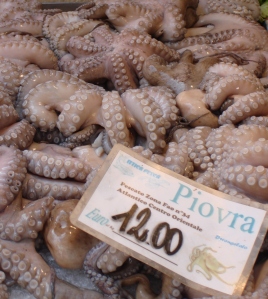A recent visit to my father’s hometown of Abbadia San Salvatore in Siena gave me interesting insight into the concept of dialect. Family had taken me to a local restaurant, and the cousins who’d since moved out of town ordered “una latina di Coca Cola” or a can of Coke. Those relatives who still resided in town similarly ordered Cokes, but pronounced it much differently, dropping the hard C sound entirely, instead asking for “O’a-Ola.” As any native Bostonian knows, dropping a letter (like an R) gives the English language a certain flair all its own, and certainly gives the listener an indication of your proud heritage.
A map of Italian dialects (click on image for larger version – courtesy zingarate.com)
As a native of Buffalo, where the words “merry,” “Mary,” and “marry” are pronounced the same way, and where “pop” means “soda,” and the word “hot” and “cod” take on a nasally, back of the throat twang, it’s clear to me that my husband, Jamie, who hails from north of Boston, speaks differently. When he says the word “pattern,” I must rely on context to determine whether he’s saying “Patton,” “pattin’,” or “patent.” When I first met my husband’s mom at the Cape, she suggested, “Go put ya shahts on [for the beach],” I merely stared back at her, confounded. Jamie translated, “Gina, my mom’s asking you to change into your bathing suit,” so I smiled and nodded, and she and I have gotten along swimmingly since then. The same is likely true for many Bostonians and their extended families. Their backgrounds – whether they were born in Boston or in Italy, or whether residing in the North End or Braintree – determine their particular pronunciation, grammar, or vocabulary. But just like Nonna’s minestrone, it’s the variety of the flavors that makes the mixture so delightful!
The factors that typically influence the development of dialects in a region or country include: geographical location (people living in close proximity to each other, as well as people living in isolation from others); socio-economic conditions; complex colonial history; movement of ancestry; strong regional loyalties; and the cultural influence of nearby communities. In such regions or countries, a dialect that is commonly used in the media (as in entertainment and news programming,) may be very different from the dialect used in official government business, in schools curricula, and in everyday street language. For example, a Boston news anchor may articulate the English language differently than a meter reader in Quincy. Either way, they both get their points across, perhaps one more colorfully than the other.
There are two major groups of Italian dialects -Northern and Southern, divided by the Spezia-Remini line. The northern groups are either: a) based in Veneto and speak a Venetic dialect; or b) of the Gallo-Italic group that encompasses most of the rest of the region, and is influenced by Celtic speech. As for the rest of the boot, the most common Italian dialects include: Tuscan (most of Tuscany); Abruzzese, Pugliese, Umbrian (near Tuscany); Laziale, Central Marchigiano (in and around Rome); those common to the southern part of Italy (like Napolitano); or those indicative of the outermost regions of the south, including Calabrese, Apulian, and Sardinian dialects. The rich variety speaks to the turmoil that Italy endured on the way to its unification in 1861. Only an official republic since 1946, Italy’s cultural pride is highly regional to this day. Where the Tuscan dialect is considered the national language or the “lingua italiana,” perhaps because the area is considered the birthplace of Italian literature (as in Dante, Petrarca, and Boccaccio,) still, different regions proudly embrace the differences that distinguish their manner of speaking from others in their country, much like Bostonians.
There are many other countries with multiple dialects of the same language, including Spain (10 recognized dialects), India (400 languages, and an estimated 2000 dialects), Asia (Japan has dozens, and China has at least 200 dialects), and many more all over the world. Dialects add color and diversity to language, and infuse flavor into one’s culture. After all, wouldn’t you rather have a “wicked good” cannoli than just a good cannoli?



